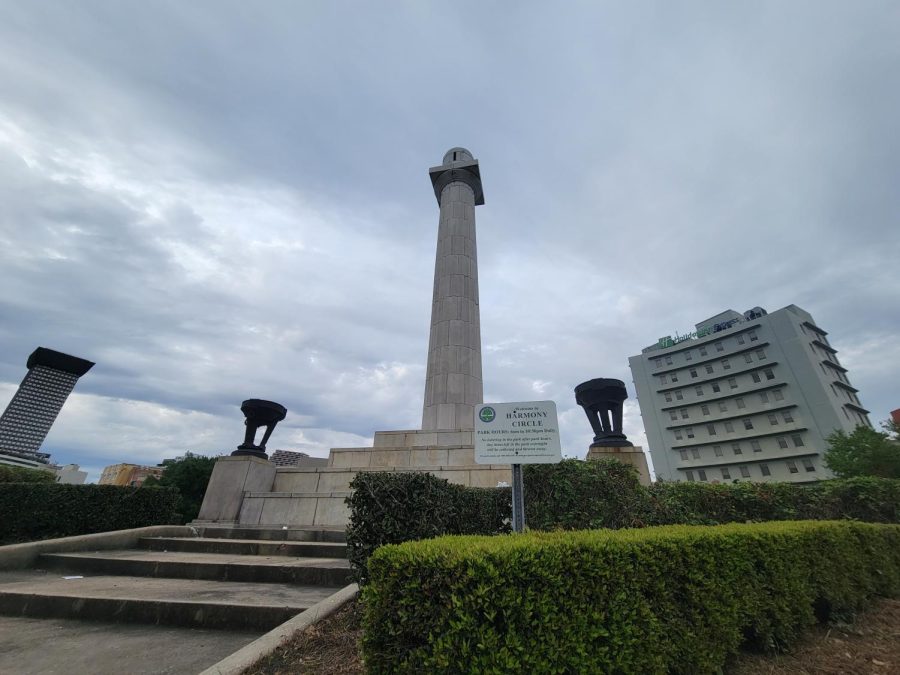Future of Harmony Circle’s center still uncertain
Harmony Circle’s pedestal still stands without a monument on March 14. The pedestal once housed a statue of Confederate General Robert E. Lee.
March 19, 2023
As we come up on the six year anniversary of the removal of enslaver and Confederate General Robert E. Lee’s statue from the center of Harmony Circle, all that currently remains in it, aside from some shrubbery, is the pedestal which once housed his metal form.
Loyola art and design professor Manol Gueorguiev, said even the pedestal itself is something we must think carefully about when removing or replacing.
“The pedestal still overpowers the intersection and there is an immediate knee jerk reaction to wipe that space clean,” Gueorguiev said. “However, removing it would, to some degree, remove the memory of the negative history as well.”
In 1884, 19 years after the Civil War ended, the pedestal was built to house the Lee statue. That same year, the circle, which stands at St. Charles Avenue between Uptown and downtown New Orleans, came to be known as Lee Circle.
The statue was removed in 2017, despite four lawsuits in federal court that helped to stall the process after the City Council voted for its removal in 2015.
Five years after the statue’s removal, it was renamed Harmony Circle, and a temporary statue by renowned Black artist Simone Leigh stood beside the looming pedestal for about seven months that same year. “The Sentinel” was of a woman wrapped in a snake, and was showcased as part of Prospect.5, an exhibition in New Orleans that sought to “search for alternative models for New Orleans monuments, which were historically devoted to mostly militaristic, often racist, white males,” according to Nola.com.
“Simone Leigh, who created the Sentinel sculpture and the opening performance ceremony which contained a talk, a poetry reading, and performance, offered a new interpretation of the space,” Gueorguiev said. “Simone Leigh is a very important artist, but how do you account for the desire of each generation to account for that space and history? Why choose an object to replace the Lee statue and pedestal? Why not a cultural center that produces knowledge and discusses that moment in history?”
Karl Connor, who served as the chairman of the Street Renaming Commission which recommended the circle for a new name, said the hope of the commission following the name change was that the site be used as “a unifying point so that in the future we could recognize other members of our community who had done really wonderful things, not just for New Orleans, but the country and the world at large.”
The temporary statue did not involve the commission, but was arranged by the city. As it currently stands, the Downtown Development District agency has no plans in the future for the space. Davon N. Barbour, the president and CEO of the agency, said they hope to raise funds to improve the site.
“Long term, what I would like to see happen, is that they do use the circle as a space that brings together the community as a whole so that it can reflect on the multitudes of people that have come through here,” Connor said. “In a perfect world, every year, in coordination with some other event that could help bring together some of the other historic assets in the city like the New Orleans African American Museum, the Midlo Center, the Louisiana Civil Rights Museum which is set to open this summer, you know all those historic assets could come together so that once a year we could use what is now Harmony Circle as the impetus to have conversations, more broader and robust conversations, about exactly how we got to where we are today, and how we can move forward and learn to live better together, not just tolerate each other.”
And there is a wealth of people to choose from.
“We’ve lost, as a city, a number of people who were born and raised here, who went on to other cities, and their greatness was really recognized there. A good example of that is Andrew Young, born and raised here. Everybody gives him to Atlanta, right? We need to reclaim our folks,” Connor said.
Andrew Young was a civil rights leader who served in the U.S. House of Representatives and later as mayor of Atlanta.
“We need to reclaim those folks, because when we have conversations about how we fix New Orleans, you know, quote-unquote fix New Orleans, we always talk about examples for the people who live here, particularly the youth who live here, to be able to follow to see that success is possible,” Connor said. “There is no concerted effort by New Orleans to tell those stories.”
When looking for good examples of statues or art a space like Harmony Circle can feature, Gueorguiev pointed to the Mardi Gras Indian suit that appeared at the site of the former Jefferson Davis statue at the cross-section of First and Camp Streets. The nine-foot-tall suit’s surprise appearance was done by Demond Melancon, Big Chief of the Young Seminole Hunter tribe, along with the help of some “fairy angels” without city permission, Nola.com said. Melancon told Nola.com the act was a way to bring people together safely amidst the COVID-19 pandemic that canceled Mardi Gras that year.
Despite efforts to remove statues and street names that honor former slave owners, white supremacist figures, and Confederacy leaders like Lee, many remain. Some are especially close to home for Loyola’s campus.
37 streets were brought up for name changes by the Street Renaming Commission, and seven have happened so far. Four of the street names that have yet to be changed have name change suggestions in direct relationship to Loyola.
“None of those have been moved on, and I don’t think anybody will move them from the council’s perspective without some push,” Connor said. “Every school in this city has people on that list who they should be pushing to have these things moved and done.”
The future for many of these streets and spaces remains uncertain, just as the future of the city, country, and world at large does.
“Harmony suggests resolving an issue when in fact the issues have not been resolved,” Gueorguiev said. “Racism is ongoing and public spaces are still charged and fraught.”








